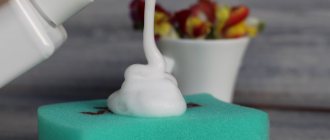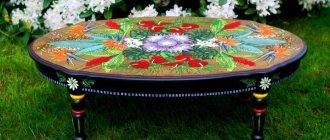How to paint plastic with your own hands? Features and nuances of painting plastic at home.
How to paint plastic with your own hands?
Features and nuances of painting plastic at home. Decorative items give the interior of any room a unique and finished look. If you want to decorate your apartment and create a stylish interior without spending too much money on decoration items, then the easiest way is to give a second life to plastic objects and surfaces by painting them with beautiful spray paint. The process of painting plastic with your own hands, if you are well prepared, will not take much time and will not be too difficult.
Surely at home you have a lot of objects made of plastic, polypropylene, polycarbonate, polystyrene - in everyday life all these materials are called plastic.
If you are reading this article, then you are interested in the topic of painting plastic products, and you already have a lot of questions about this: how and with what to paint plastic with your own hands? how to prepare plastic for painting? Do the properties of different types of plastic affect the dyeing process? Is it necessary to prime plastic and others. We will talk about all this in the article.
What do you need to color plastic at home?
— aerosol acrylic enamel or special paint for plastic in sufficient quantities
- aerosol acrylic varnish, glossy or matte - for final finishing
- gloves and mask or goggles for protection
- newspaper or covering film
- paper tape (painting tape)
- a bowl of water, cotton rags, detergent
- solvent or white spirit
- fine sandpaper
— ADDITIONAL: If you want to remove deep scratches and chips on the product, you will need putty (preferably automotive) and primer
How to paint plastic at home?
Not every paint is suitable for painting plastic objects. Some types of paints simply will not adhere to the product. Therefore, for working at home, it is best to use aerosol paint in cans, universal or special for plastic, which is easy to apply and does not require special work skills - a little skill, strict adherence to step-by-step instructions and you will succeed. However, some people prefer to use traditional paints for painting, so in the second part of the article we will talk about how to paint plastic with a brush.
Step-by-step instructions for painting plastic
Step_1 Clean the plastic surface from dirt using a sponge (brush) and soapy water. If dust and dirt remain on the product, the paint will not apply evenly and the product will have to be repainted. Heavy soiling, mold and erosion can be cleaned with bleach. Before starting work, dry the plastic product thoroughly.
Step_2 To degrease the surface, wipe it with solvent or white spirit, then rinse off the applied composition and dry the product thoroughly.
Step_3 To create a porous structure, sand the surface with fine sandpaper or a special grinding machine. Sanding will allow the paint to lie perfectly flat, due to the bonding of the paint and the porosity of the surface. After sanding, the surface will become matte. Correctly selected sandpaper will not give the product unwanted roughness, so it is better to choose sandpaper with a grit of no more than 180. Be sure to remove dust from sanding.
Step_4 Before painting the plastic at home, cover the areas that are not to be painted with construction tape and remove it immediately after finishing the work.
Step_5 Now you can start painting the plastic with spray paint. Shake the spray in the can for at least 30 seconds, spray the aerosol paint from a distance of 20-30 cm from the surface. You need to apply the paint with smooth, even movements. After the first layer has dried, which will take 15-20 minutes, apply subsequent layers of paint. When painting plastic, it is recommended to apply at least 2 - 3 layers of paint.
Step_6 After the spray paint has dried, apply the varnish in the same way and wait for it to dry. Complete (final) drying takes no less than 2 - 2.5 hours. The product is ready to use!
What to pay attention to when painting plastic?
As we have already said, there are different types of plastic, so it is recommended to carefully choose the paint. Ideally, you need to use special paint for plastic.
1 It is better to paint soft plastic products with elastic enamels, which contain a high content of plasticizers
2 Hard plastics can be easily processed with universal acrylic enamels
3 Don’t forget to pre-prime plastic surfaces to improve their adhesion
4 The following types of plastic cannot be painted: polystyrene, polycarbonate, polyethylene
5 In addition, please note that for aerosol paints in cans there are special tips for convenient regulation of the amount of paint sprayed and its uniform distribution
We talked about the simplest and most effective way to paint plastic at home using aerosol paints, but this procedure can also be carried out with a regular brush using canned paint.
How to paint plastic at home with a brush?
Painting plastic objects with a brush is somewhat different from the method described above and has its own advantages and disadvantages. One of the features is considered to be a long drying time, which means that the product must be completely isolated from dust on the newly painted surface, which is not so easy at home. This is why the brush painting method is used to paint objects that do not require special attention. The technology for painting plastic with a brush at home is quite simple and essentially repeats the process of working with aerosol paint:
Step_1 Wash the product before dyeing. Dry it.
Step_2 Degrease the surface, wipe and dry the product
Step_3 Sand and apply primer
Step_4 Apply paint
Step_5 This is an optional step. If you want to further protect the painted surface, you can apply acrylic varnish. Apply varnish ONLY to completely dry paint. In the case of aerosols, we know that the paint dries in 15-20 minutes, but here everything will depend on what kind of paint you use. Varnish drying time 2 - 2.5 hours
What should you pay attention to when applying paint to plastic with a brush?
1 Apply paint in a thin layer, constantly pressing the brush to the surface
2 When taking paint onto a brush, do not immerse the brush completely in the paint.
3 Take into account the painting angle - it should be the same.
4 For even coverage, apply the paint in wide stripes so that the paint fills the pores, and then carefully blend the applied layer.
Drawing on a chair
Do you like to draw and create beauty with your own hands? Then you'll love chair painting! Traditional scenes for the New Year: snowmen, New Year's inscriptions, animals and much more. With all this, the design of each chair may vary. Painted chairs can be put away for the whole year and taken out only before the holiday, making this a kind of New Year's tradition. And if you decorate only the seat with painting, then throughout the year you can cover its solemn “look” with pillows. A variety of ways to paint chairs can be seen in the photo below.
Tip: Before you start painting, you need to clean the chair from dirt and prime it. Before priming, if necessary, you can sand the surface with sandpaper. Then the design is applied and finally varnished. The primer, paint and varnish must be on the same base.
Updating a highchair
Sometimes pieces of furniture remind us of childhood. Perhaps in your home there is a shabby old children's highchair with peeling paint. If it’s a shame to throw it in the trash, and it doesn’t fit into the interior, you can update it with simple steps. Repainting is the easiest option, but decoupage can also be done. Let's talk about it.
Materials
To work you will need:
- the chair itself;
- white paint for walls and ceilings, water-based or acrylic;
- green acrylic paint;
- soft brush;
- dishwashing sponge and clothespin;
- construction acrylic varnish;
- PVA glue;
- putty and plastic card;
- napkin with a suitable image.
Work order
First, inspect your high chair. Remains of the previous paint must be removed with sandpaper. The quality and durability of the new coating will depend on this. The second step is leveling the surface. Take decorative putty and apply it in a very thin layer. For this, not a rubber spatula, but an ordinary plastic card is suitable: its smooth sides will smooth out the paste well on the chair, without even sanding required.
Let the surface dry: a day is best; in extreme cases, you can dry the chair with a hairdryer and continue working. Cut a piece of clean dish sponge, about 2 by 2 cm, and use a clothespin to make a kind of handle: this will be our foam sponge. Start applying white paint with this tool to the surface of the chair and its back (start from the back, then move to the front side, and it is better not to touch the bottom of the chair). You need to apply the paint using blotting movements, as if trying to burst the air bubbles that form.
Let the layer dry or use a hairdryer. Now it's time to choose the background for the high chair. In this case, we take light green (white plus dark green). Using the same technique, using a sponge, apply two layers of paint in succession.
Dilute the PVA glue with water until it is liquid. Decoupage is the act of placing a layer of paint on an object using a serving napkin. You can find a wide selection of them in stores. In this case, it is better to tear out the motifs from the napkin rather than cut them out (this way they will blend better with the surface). But if the design has clear edges, you can carefully cut it along the contour with sharp nail scissors. We have a napkin with butterflies. We cut out the butterflies, even if the motif is incomplete (we will place it on the side).
First, glue the central motif onto the seat (three butterflies). To do this, place the drawing in the right place, start applying glue with a soft brush, starting from the middle of the image. Gradually adding glue, carefully smooth the napkin, aligning the image. Be careful not to tear the paper. If you are just starting to learn the decoupage technique, then take small motifs: they are easier to handle.
In the same way, we place all the butterflies on the seat of the chair and its back.
After the glue has dried, all that remains is to attach the back in place and cover all the beauty with two layers of acrylic construction varnish.
So, the new piece of furniture is ready! You can find a suitable place for it!
Decorating chairs using fabric
There are often situations when, during renovation, owners completely change the colors of the walls and the furniture no longer matches the new interior. What to do? It’s a pity to throw away comfortable and high-quality chairs. Decorating chairs with fabric will come in handy here.
The main thing with this method of updating chairs is to choose a durable and reliable material that matches the color of the finish. It can be microfiber, jacquard or furniture silk, but most craftsmen still recommend using tapestry. This fabric is characterized by high wear resistance and durability due to the inclusion of artificial fibers in its composition.
Scheme for measuring the chair and draping the cover.
If you need to decorate chairs for a holiday, you can choose a more elegant fabric with thematic designs, without paying attention to its performance characteristics, because when the holiday passes, the decor will be removed from the chairs. If we are talking about reupholstering furniture to meet the requirements of a new interior, the material must be very durable, easy to clean and not subject to contamination.
In addition to the fabric, you will need to prepare the following tools and materials:
- a piece of foam rubber;
- thin batting;
- furniture braid or tape;
- construction stapler;
- furniture glue;
- sandpaper;
- scissors;
- pliers;
- knife.
First of all, you need to pay attention to the reliability of the chair design. If it is old enough, creaks and wobbles, all the parts need to be disassembled, the fastening points checked for strength, the grooves cleaned with sandpaper, removing irregularities, and then the structure must be put back together, gluing the parts with furniture glue.
Related article: Correct connection of spotlights with your own hands
If the chair is strong and reliable, you can immediately begin decorating. To do this, place a piece of foam rubber corresponding to the size of the seat on the base. Then the foam rubber is covered with a sheet of batting, which has an allowance on each side 5 cm larger than the size of the seat. The third layer will be a piece of fabric the same size as the batting. The batting and fabric are folded under the base of the seat and secured on the underside using a staple gun. Excess material is trimmed with scissors.
Schemes for decorating chairs using fabric.
When cutting material for decorating chairs, close attention should be paid to the location of the design or pattern. It is better if it is located in the center of the seat. In order to correctly position the pattern, it is advisable to first mark the fabric with a pencil or chalk, and only then cut out the parts.
Decorating the back of a chair is similar to decorating a seat: first, foam rubber is applied to the element, then batting and fabric. The edges of the batting and fabric are folded over and secured to the chair using a stapler. In order to hide the paper clips, the seams are decorated with thick braid or tape. Transparent wood glue is used to attach it.
Benefits of DIY restoration
A chair that is updated at home can be designed better than it looked before. Restoration requires a minimum of materials and tools. Replacing holey or worn upholstery is a matter of one hour.
If the chair is antique, then it must be restored very carefully.
You can independently clean the wooden surface of old furniture and cover it with a transparent or tinted composition, or introduce new elements into the decor. For example, a chair is made with carved legs or a back, and the seat is reinforced so that it can be used for its intended purpose for a long time.
For restoration, many materials are available in the house - a piece of thick fabric, foam rubber, etc.
The costs of restoration at home are minimal. Before buying a new chair, think about whether it is possible to restore the old one and save a lot of money. Restoring antique furniture is especially expensive because it requires great care and exclusive materials. Updating furniture on your own will cost much less.
The updated chair, covered with a beautiful varnish, looks no less neat than when purchased.
Reupholster an old chair
A quick way to update a chair is, of course, to reupholster the stool and give one of the sweaters a new use . The only cost will be the purchase of paint.
- Chair
- Paint (wood enamel or regular acrylic)
- Brush
- Construction stapler
- Sweater
- Construction adhesive
Step 1: Making a new skin
- You need to unfasten the seat from the wooden structure of the chair, and then cover it with a knitted sweater and secure it around the perimeter with a construction stapler.
- Of course, you can also use fabric for covering, but here we are considering the simplest and cheapest option from scrap materials.
Restoration process: step-by-step instructions
If the “original” bolts connecting the supporting structure become loose, they are strengthened with an additional washer. For greater reliability, you can add a little universal glue to the grooves.
Replace the sea grass and horsehair used in the old days as fillers with foam rubber.
A leaky seat is updated by replacing the base with slats and/or the upholstery is completely restored. The worn surface is freed from old material. The chair is prepared for further restoration:
- cut a piece of plywood to fit the seat;
- glue foam rubber onto the base (width - 3-4 cm);
- fix the plywood around the perimeter;
- stretch the upholstery fabric onto the finished base;
- secure the material with a stapler and staples.
A chair that is updated at home can be designed better than it looked before.
You can completely replace the back with a curly one, if the design allows.
You don't have to place the fabric on the outer sides of the seat. Then the upholstery is folded inward around the perimeter. The seat frame will be visible.
The fabric chosen is resistant to abrasion and mechanical stress, and quite dense.
A restored chair can be further decorated - make the wooden surface lighter or darker, or design the back or legs differently.
Replacing holey or worn upholstery is a matter of one hour.
When updating, you can use a variety of materials. With good carpentry skills, a restored chair acquires an individual style. This takes into account the material - wood type, density, texture.
| Scratch (crack) size | Means |
| Small shallow scratches | Iodine solution |
| Small cracks | Putty (carpentry, automotive) |
| Deep scratches | Shoe polish, mastic (heated beeswax + turpentine in a ratio of 4:3) |
You can independently clean the wooden surface of old furniture and cover it with a transparent or tinted composition, or introduce new elements into the decor.
The chairs included in the set must be decorated in the same style.
If the chair is antique, then it must be restored very carefully. Be sure to give the applied composition time to dry.
For an antique chair, choose decorative material with embroidery.
For your information. Antique chairs often have springs in the seat area, so you will need to find the same or similar ones, and remove old ones that have rusted and lost their elasticity. Replace the sea grass and horsehair used in the old days as fillers with foam rubber.
The costs of restoration at home are minimal.
Round the edges using a jigsaw and sand the edges with sandpaper.
Required materials and tools
To restore the chairs you will need the following:
- quick-drying varnish (clear or tinted);
- dye;
- upholstery fabric;
- foam;
- plywood;
- sandpaper;
- metal washers and bolts (screws);
- springs (for a specific type of chair).
Sandpaper will be needed to clean the surface of the furniture from uneven surfaces, chips and cracks in the varnish.
The fabric chosen is resistant to abrasion and mechanical stress, and quite dense. Tapestry, flock, matting, etc. are suitable. For an antique chair, choose decorative material with embroidery.
Updating furniture on your own will cost much less.
Select the wooden base according to its density and texture in advance, cut it to size and use a pattern to create the desired design.
Sandpaper will be needed to clean the surface of the furniture from uneven surfaces, chips and cracks in the varnish. It is necessary to completely sand the chair (wooden structure) for a smooth application of the laminating compound.
For major repairs, the chair can be disassembled, the broken parts replaced with new ones and fastened with bolts or screws.
To update the chair, you need the following tools:
- scissors;
- roulette;
- wood saw (saw off excess plywood under the seat);
- screwdriver;
- screwdriver.
For greater reliability, you can add a little universal glue to the grooves.
For major repairs, the chair can be disassembled, the broken parts replaced with new ones and fastened with bolts or screws. Seat frames also often require restoration.
Seat frames also often require restoration.
A Viennese chair or any other looks best in this design.
Important! It is necessary to use wood species that are similar in density and texture so that the chair is functional and looks presentable.
A leaky seat is updated by replacing the base with slats and/or the upholstery is completely restored.
Methods of restoration by decorating a chair
There are several options for designing the appearance of furniture. The chair can be updated in the following ways:
- coloring;
- lamination;
- decoupage
It is necessary to use wood species that are similar in density and texture so that the chair is functional and looks presentable.
As decoration, you can use both the upholstery itself, choosing a fabric of interesting colors like a tapestry, and other parts of the furniture, making them carved and figured.
You don't have to place the fabric on the outer sides of the seat.
A plain seat is decorated with smooth embroidery or appliqué. This must be done before starting the sheathing.
A plain seat is decorated with smooth embroidery or appliqué.
The wooden surface of the supporting structure and the back are laminated, that is, covered with durable varnish in several layers. The tone of the coating is selected closer to the natural shade of the wood (light, dark or moderate). A Viennese chair or any other looks best in this design.
A restored chair can be further decorated - make the wooden surface lighter or darker, or design the back or legs differently.
You can completely replace the back with a curly one, if the design allows. Select the wooden base according to its density and texture in advance, cut it to size and use a pattern to create the desired design. Round the edges using a jigsaw and sand the edges with sandpaper.
The wooden surface of the supporting structure and the back are laminated, that is, covered with durable varnish in several layers.
The chairs included in the set must be decorated in the same style so that they do not stand out from the overall picture - “different-sized” furniture may look good in different rooms, but at a common table, for example, when celebrating a family celebration, it looks careless.
When updating, you can use a variety of materials.
Updating kitchen chairs
Here we will update a set of four kitchen chairs by painting the legs and backs white and the seat dark brown.
The scheme of work is similar to that described in the master class on updating a wooden stool.
- First you need to remove the old paint using sandpaper,
- then alternately paint the seat dark and the rest of the chair white,
- and at the very end apply a protective coating.
The difference is that here this process will take longer due to the larger number of elements to be painted.
Follow these step-by-step instructions for upgrading your farmhouse style stool and you'll end up with this awesome chair:
Don't be afraid to experiment with paint colors and upholstery fabrics, or adding a vintage effect. Make the chairs suitable exactly for your taste and interior!
Chair Painting Ideas
Painting your chairs a different color is the most versatile way to make them look modern and stylish. Below in the photo we have given several ideas for decorating chairs.
What you should stock up on before starting work
To ensure that painting a chair with your own hands is of the highest quality, you should make sure that all materials and tools meet the highest standards:
- First you need to decide how to paint your wooden chair. Acrylic or alkyd paints are suitable for this. The second option is preferable due to the durability of the coating and the absence of an unpleasant odor during operation. In addition, the acrylic component perfectly protects the wood from damage and moisture.
High-quality composition guarantees the durability of your finish
- If you want to preserve the texture of the wood, you should purchase a special furniture varnish. It is resistant to abrasion and can withstand various adverse impacts. In addition, such surfaces are easy to clean.
Polyurethane-based varnishes can perfectly protect the surface
- You can simplify the process even further and purchase paint in an aerosol can. Its price is much higher than that of conventional solutions, but doing the work yourself is much easier and more convenient.
Using a spray can you can easily achieve a perfectly even, streak-free coating.
- To clean the surface from any remaining old paint, you will need sandpaper. It is better to purchase several types - from the coarser to the finest, so you can ideally prepare the wood for painting.
Abrasive paper differs in the grain size of the abrasive material
- Painting chairs is done using brushes, unless, of course, you purchased an aerosol can. It is better to buy several brushes of different widths to ensure maximum ease of use.
Advice! If there are small chips or cracks on the surface, they must be repaired using a special wood putty. But in this case, the chair will have to be painted so that the finishing areas are not visible. And you should not use this composition on large uneven areas and cracks - during use, a large layer of putty may simply fall off.
If you have upholstery on the seat or backrest, you should stock up on a piece of fabric, foam rubber and a construction stapler to repair this element as well. The color and texture of the upholstery is selected in accordance with the desired design style. It is better to choose reliable and durable furniture fabrics.
Surface preparation
First, you need to remove the old varnish or paint from the chair.
Before starting restoration work, you should prepare the chair and thoroughly clean it from the old layer of paint. To do this you will need tools and devices such as:
- steel wool, sandpaper or electric sander;
- clean rags;
- a bucket of soapy water;
- gloves, mask and goggles;
- old newspaper or magazine sheets as bedding;
- film;
- screwdriver (depending on the type of chair);
- hammer or nail puller;
- primer (depending on the type of stool);
- roller;
- strengthening wax or wax balm;
- putty;
- wood spatula (depending on the type of chair).
Pre-treatment of stool is carried out in several stages of manipulation:
- Wash the entire surface of the chair using soapy water and rags. Clean the backrest, seat top and bottom, legs, connecting elements from cobwebs, debris and accumulated dust. Let it dry.
- Check furniture for cracks, chips, crevices and loose bolts. If necessary, connections must be strengthened with self-tapping screws. Small cracks and chips should be repaired by applying putty and a wood putty knife, but the composition is not suitable for sealing large cracks or irregularities, otherwise the putty will simply fall off during use. This finishing seam will not be noticeable under the paint, so it will not spoil the appearance.
We invite you to familiarize yourself with a do-it-yourself arched greenhouse made of polycarbonate drawing
If necessary, you need to repair the chair, for example, you can use “liquid nails”
- Remove the old upholstery from the back and seat. Turn the chair upside down, unscrew it with a screwdriver or separate it from the frame with a nail puller. Then gently tap with a hammer.
- Thoroughly clean old coatings. Using sandpaper or a sponge, remove the worn layer of paint or varnish from the stool. Paint thinners are not recommended for use on wood or plastic due to the corrosive substances they contain. Processing continues until the old layer is completely removed. A sander will speed things up a lot. Sanding work must be carried out with gloves and a mask. Periodic wiping with a damp cloth will simplify the process and remove dust. Do not be afraid of the varnish becoming viscous due to moisture - this is a completely normal phenomenon.
- A primer (applied to the wood surface) will ensure even distribution of the paint. Apply two layers to all parts of the chair. After the first layer, the surface is lightly sanded again, wiped and covered with a second layer of colorless primer mixture. Next, a strengthening wax balm is applied to the stool, and everything is polished with a brush.
- Wipe with a damp cloth. It is necessary to rinse the chair to avoid any remaining debris from mixing with the paint, which would make it difficult to apply with paint and make the surface rough. Wait until completely dry.
How to carry out work
So, how to paint wooden chairs so that the coating is not only beautiful, but also durable? In fact, the process is quite simple and consists of two main steps.
Product preparation
At this stage the following activities are carried out:
- The reliability of all connections is checked; if necessary, they need to be tightened or the fastenings strengthened using self-tapping screws (it is important that they are not visible on the surface).
- The soft elements on the backs and seats must be removed, and then the old upholstery must be removed. The new material with foam rubber is carefully attached with a stapler, so you can repair the seat very quickly and easily.
- Before painting an old chair, remove any remaining coating from it. It is not recommended to use various solutions, as they can damage and even deform wood that is decades old. The work is carried out with sandpaper, the process is quite long and painstaking, but it cannot be done without it.
Surface treatment should be continued until it is completely clean.
- To achieve a perfectly smooth surface, after removing the layer of old paint, it is processed with fine sandpaper. This allows you to make the planes very smooth.
- The last operation is to thoroughly clean the entire product from dust; this must be done carefully, since the entry of such impurities into the paint will make the surface rough.
Applying paint
Using the right combination of paint and upholstery can transform the look of your furniture.
After preparation, you can proceed to the main stage - applying the composition to the surface. If there are elements on the furniture that do not need to be painted, they must be covered with masking tape.
Advice! If you paint from a can, do all the work outside so that fine dust from the paint does not get into your eyes or onto the walls indoors.
The work is carried out in several stages. First, the first layer is applied, which, due to the characteristics of the wood, raises the pile on the surface. After the composition has completely dried, the pile is removed with fine sandpaper, and the surface becomes perfectly smooth.
Next, apply one or two more layers, depending on the hiding power of the paint. Each subsequent layer is applied after the previous layer has completely dried.
If you decide to apply a design to the surface, it is done on top of the last layer, and it is best to use paints on the same base as the main coating.
The final stage is treatment with transparent furniture varnish, which makes the surface wear-resistant and durable.
Sometimes the question arises of how to paint an old metal chair.
To do this, you can use a wide variety of compositions:
- If you need a steel-colored surface, Zinga electrically conductive paint is perfect, as it protects the metal well.
- You can also use fire-retardant metal paints Polistil; they not only protect the chair, but also make the surface impervious even to open fire.
How to reupholster a chair
Agree that sitting on a soft chair with beautiful upholstery is much more comfortable and pleasant than sitting on a hard wooden seat. The bench that we will transform here is suitable for a piano, to be placed in the bedroom near the bed, and as a chair for changing shoes in the hallway. Let's take a closer look at how you can update the upholstery of a stool and reupholster it with new fabric.
TIP: If you have a leather seat, read the article on how to paint leather furniture.
The entire project takes less than an hour and is really easy to do yourself.
- Wooden piano bench
- Upholstery fabric
- Scissors
- Decorative nails for furniture
- Hammer
- Glue gun
- Sintepon
Step 1: Paint the bench
You can skip this step if the bench is in good condition and doesn't need painting, but you just want to soften it up. If painting is necessary, first remove the old paint with sandpaper, and then apply new paint and leave to dry.
Step 2: Attach the fabric
Lay out and level the fabric on the surface of the bench, tuck one side (short) by about 2 cm, and secure it to two legs (to do this, use two decorative furniture nails, one on each of the two legs), as in the photo.
After this, carefully wrap the fabric around the corners of these two legs and secure its position with a glue gun (see photo).
Now it becomes clear how much fabric needs to be removed. Leave about 2-3 cm to tuck, and trim the rest (this applies to all sides).
Then secure the fabric to one long side of the stool, and then to the other short side in the same way as you just did on the short side. That is, fold the fabric, secure it with a glue gun and nail it with decorative nails. After this, one long side of the chair remains with loose upholstery; we leave it for filling with padding polyester.
Attach three nails at each corner: one right at the corner to hold the folded fabric in place, and two at the edges of the legs (at this point this includes the two legs on the long side of the chair with the trim attached).
Step 3: Making the upholstery
Now is the time to add padding polyester. You need to do this a little at a time to evenly distribute it over the chair under the fabric. Add padding until the seat is soft enough without putting too much tension on the fabric.
Now all that remains is to secure the fabric on the remaining side and on the corresponding two legs. The procedure is the same as in the previous step with the other sides and legs.
Note: the number of nails between the legs of the stool may vary, but it is sufficient to hold the fabric (here the distance between the nails is approximately 3 cm).
The bench has acquired a completely different look and can now serve as a real highlight of the interior!
Types of paints for wood
Builders have a joke that wood can be painted with almost any paint. And, it’s true, but a small list of funds is not suitable for this. Therefore, paint for wooden furniture is divided according to the type of coating and its properties.
Varnishes, impregnations, stains
These are substances that are either colorless or with coloring pigments. They allow:
- emphasize the structure of the wood without painting it;
- the product “breathes”, absorbing/releasing moisture into the room;
- protect the product from negative environmental influences such as burnout
You need to varnish either new furniture or furniture that has been well preserved. Such products fit perfectly into a classic interior or eco-style. It is also important that in the future, for a new change, you will not need to remove the varnish; it can be updated from above.
Dispersion paints
Painting wooden furniture with water-soluble compounds is now very popular. The water in them is a solvent, and the binder is a polymer resin. Such popularity is not surprising, because most often it is odorless paint, which makes it indispensable for children's furniture.
It is also important that it dries quickly, is waterproof and vapor-tight. When working with it, you should not be afraid of the release of harmful substances. A wide selection of colors will allow you to choose your unique color. The coating can be either matte or glossy.
It is a pleasure to paint a product with her. This group also includes acrylic paints, which are characterized by increased durability and all the other advantages of water-based paints.
Organic solvent-based enamel and paint
This paint for wood furniture is less popular now, but literally 5-10 years ago it had no equal. And the reason for its unpopularity is toxicity, fire hazard, unpleasant odor and long drying time. Its undoubted advantage is its low price, especially in comparison with acrylic paints.
After drying, a layer is formed on it that protects the product from high humidity. Because of this, it is often used for rooms and furniture that may frequently come into contact with water.
Important! The protective barrier against water does not allow the product to “breathe”. To use such paint, the wood must be completely dry, otherwise peeling and paint shedding cannot be avoided.
Simple decoupage of an old stool
The simplest way to decorate old furniture is to apply wallpaper to its surface. Decoupage of an old stool is made from the remnants of various unnecessary wallpapers that lie idle in almost every apartment. If you can’t find them, you can buy a covering with any pattern.
It is important to know: before you start, you need to clean it thoroughly. All cracks are covered with putty, and irregularities are sanded with sandpaper.
The final result depends on a clean and smooth surface of the furniture. Even a small crack can ruin the appearance of the product and shorten the life of the finished item.
The easiest way to decorate furniture is with patchwork technique. It is the simplest and most pleasant. Whole pieces of wallpaper are used for it. Glue the sheet onto a cleaned and flat surface and leave it until completely dry. When the wallpaper is dry, it can be varnished so that the design does not wear off over time.
Decorating a wooden chair with newspapers is the most economical option. Furniture finished in this way looks attractive.
To decorate a stool with newspaper you will need:
- newspapers;
- decoupage glue;
- clear primer or acrylic clear varnish;
- several brushes of different sizes;
- sponge.
Master class for beginners on decoupage with newspapers:
- First, prepare a chair for work. The entire surface is cleaned with fine-grained sandpaper. After this, decoupage glue is applied with a wide brush.
- Before you start gluing newspapers, you should put them in a bowl of warm water for a few minutes.
- Wet newspapers are placed on the stool.
- All irregularities are immediately smoothed out from the center to the edges.
- The pasted piece of furniture must dry for at least a day.
- After drying, a transparent primer is applied to the newspapers in 5-6 layers.
What do you do with old furniture?
, among which are sometimes pieces of furniture that were very useful, but are outdated and are usually replaced.
But even if you bought a new piece of furniture to replace the old one, you can turn the latter into something different, but no less useful.
Old chairs can be found in almost every home, and if you really want to replace them, you still shouldn’t throw them away, since old chairs can be used to make other useful things for your home, garden and cottage.
For example, you can use an old chair to make a towel rack, a garden bench, a convenient pet feeder and much more.
Here are the most interesting crafts that you can make using old chairs:
How to make a choice
Painting furniture yourself begins with choosing the right paint. And here the following points are important:
- Result: If you want the product to have a matte surface, then the coloring matter should be exactly like that. Usually they remake furniture in existing interiors. A universal solution is to paint it white, which fits organically into many styles.
- Eco-style. For lovers of natural interiors, it is better to leave the furniture in its original form, but protect it from destruction with varnish, wax or impregnation. It is recommended to use them on new furniture.
- More expensive is not always better. When deciding what paint to paint furniture with, you should not choose extremely expensive options, for example, varnish for parquet or yachts. This will not make the furniture stronger, but it will be incredibly difficult to remove it if you don’t like the result.
- Acrylic compounds. They are recommended to be used for furniture, despite the fact that there are cheaper options. And all because they have a water-dispersed base, but it is very resistant, which allows it to withstand up to 500 full washes without disturbing the appearance. This paint allows the furniture to “breathe”, which extends the life of the product. You can paint furniture with it without even removing household members from the room, because it is harmless.
- Savings. If you need to paint a large volume, but at the same time get a lasting result, then it is advisable to opt for alkyd enamels and paints. They take longer to dry, releasing harmful substances, so all work should be carried out in well-ventilated areas, but this is one of the most economical options.
- Wet rooms. Not all acrylic and dispersion compositions are suitable for them, so either choose moisture-resistant options or use alkyd ones, as they provide the necessary color durability.
- Oil, nitro paint. These substances are considered unsuitable for wood furniture and other wood products.
- Polyurethane and polyvinyl chloride. They are used by professionals, so it is better not to use them for amateur modifications. After all, their price is quite high, and it will be a pity for the money spent and the fact that the result differs from what was expected.
Decorate an office chair
A standard black office chair can be given a fun and colorful look. After such a change, your workplace will definitely become more comfortable and inspiring new productive ideas.
- Office metal chair with soft seat
- Spray paint
- Construction stapler
- Upholstery fabric
- Screwdriver
- Scissors
Step 1: Attach the sheathing
In order to make a new upholstery, you must first remove the soft part of the seat from the chair. Here you should proceed based on the method of attaching the seat to a particular chair: it can be glued or attached with screws. Remove carefully so as not to damage anything.
After this, stretch the fabric so that it fits tightly around the seat. The fabric should extend a few centimeters from the back of the seat; the excess should be cut off. We will secure the trim with a construction stapler on the back side of the seat.
Step 2: Paint the chair
Place the chair on an unnecessary sheet or old newspapers so as not to stain the floor when painting; if possible, take it outside. Choose special paint for metal. After painting, leave the chair to dry completely.
Step 3: Attach the seat to the chair
Return the seat to its original position based on how it was attached. That is, you will need either a screwdriver or glue.
Now compare the end result with what was originally. Looks like a completely different chair:
Old chairs retain the energy of past years, and often you don’t want to part with them. But how can you preserve the original appearance of such furniture without compromising its value? There is a simple and affordable way - to paint a chair in the color that the owners love. You can throw away an old thing at any time, but the best thing is to update it. Let's take a closer look at how to paint a chair and what you will need for this.










